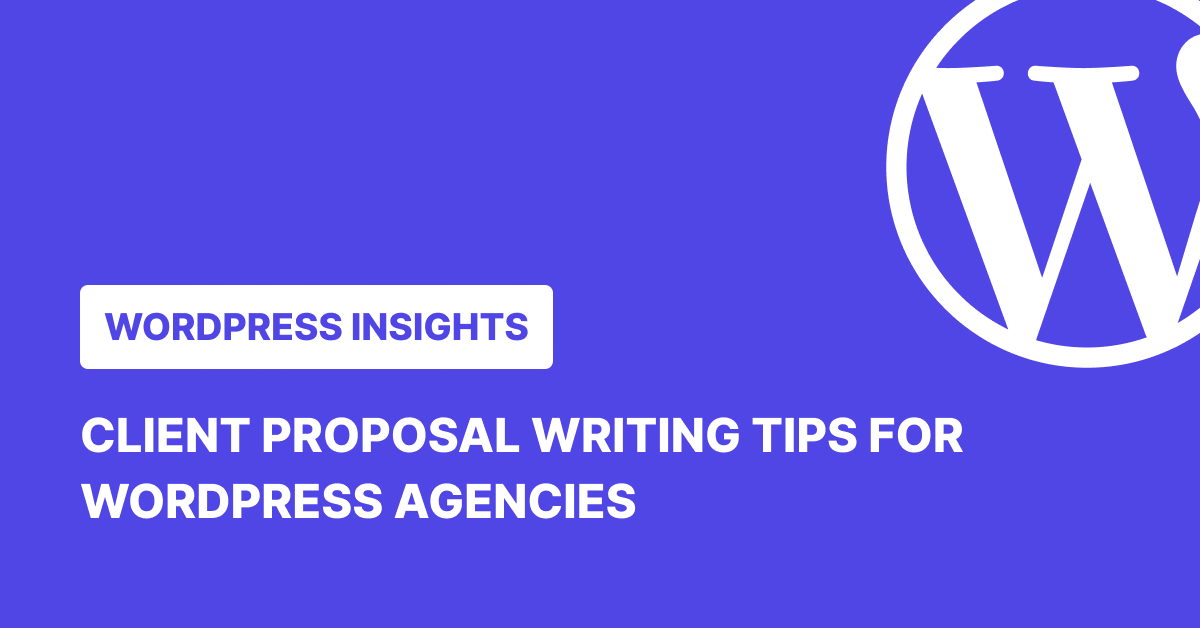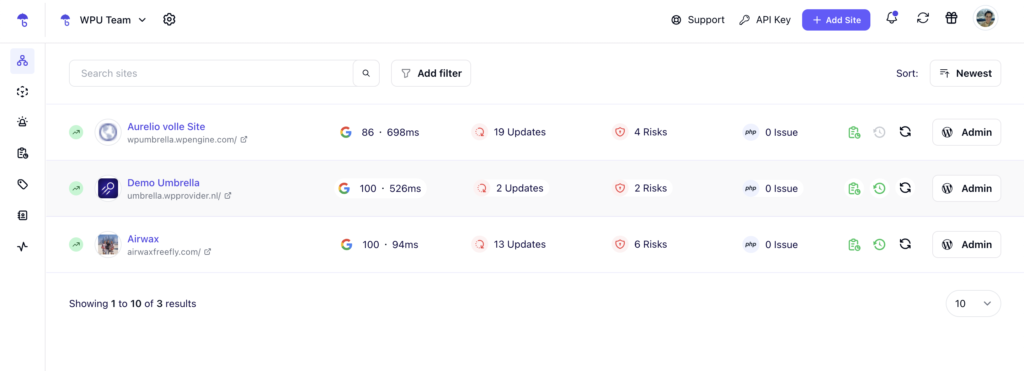Client Proposal Writing Tips for WordPress Agencies

TL;DR
A clear, well-structured client proposal shows you understand the project, builds trust, and sets the stage for smooth delivery. Focus on outlining deliverables, timelines, and value in plain language to build trust and win more projects.
If you’re a WordPress agency struggling with client proposals, this one’s for you. After a productive discovery call, turning ideas and enthusiasm into a professional, clear, and persuasive document that actually converts is no small task.
You also know that falling back on an old template with a few quick edits isn’t enough. Sloppy or vague proposals are one of the biggest reasons agencies lose deals, run into scope creep, or end up chasing overdue payments. Getting this part right is worth the effort.
So, in this post, we’ll share practical, data-backed proposal writing tips for WordPress agencies. You’ll see what to include, what to avoid, how to structure your proposal, and how to make the process faster without cutting corners.
Why Clear Proposals Win More Projects
A proposal is one of the first big touch points in a new client relationship. It shows that your process is organized, your scope is under control and well-defined, and you’ve thought through all necessary details before work begins. A client proposal also highlights how communication and deliverables will be handled.
When a proposal mirrors the client’s priorities and lays out a straightforward plan, it builds confidence. The client can see that you have listened, planned, and are prepared to manage the project. This confidence makes it easier to agree on pricing and establish expectations.
Client Proposal Writing Tips
1. Project Summary
Start with a short summary using the same language your client used during the discovery call. If they said they want a faster site to reduce bounce rates, say exactly that. If they’re rebranding, talk about consistency across design, messaging, and functionality. The summary should include what the client wants, including a list of tasks and the corresponding outcomes.
2. A Clear Breakdown of Deliverables
Transparency builds confidence. When you walk clients through what’s included (from theme development to plugin setup to on-page SEO) they understand what they’re getting and how it ties back to their goals.
Each deliverable should feel intentional. Instead of “responsive design,” say “mobile-optimized layouts tested across major devices.” That level of clarity helps the client picture the end result and not only the technical work behind it.
3. Timeline With Milestones That Set the Pace
Setting a realistic timeline gives your project momentum. It shows you’re organized, and it keeps everyone aligned.
Break the work into clear phases, such as design, development, testing, launch, and explain what happens at each stage. This creates a natural flow and gives clients a sense of progress without needing constant updates. It also helps you create check-in points where feedback is expected, which keeps projects from drifting off course.
4. Pricing That Reflects the Value
The pricing section is your space to frame the value behind the numbers you’ve quoted.
When you explain pricing clearly, along with the strategy, tools, and thinking that go into the project, it feels grounded and fair. Clients aren’t comparing line items anymore, but evaluating outcomes.
You can show the investment as a flat fee or broken into phases. Either way, clarity here leads to quicker decisions and smoother payment cycles.
5. Process and Communication
Clients want to know what working with you feels like. When you outline how communication works by explaining what tools you use, how feedback is collected, and when check-ins happen, they feel reassured.
This is where WordPress agencies have a chance to stand out. You might offer staging environments, weekly updates, or Loom videos during development. Whatever your workflow looks like, share it. Your process is part of your value.
6. Terms That Create Structure
Scope creep usually starts with vague boundaries. Strong proposals prevent that by clearly stating what’s in scope, how additional work is handled, and what your approval process looks like.
You can keep this section concise and easy to read while still covering essentials like revisions, cancellation policies, and ownership rights. The tone can stay friendly—but the structure should be solid.
When clients see that you’ve thought through every stage, they trust that you’ll lead the project with the same level of clarity.
Also read: 9 WordPress Maintenance Mistakes and How to Avoid Them
How to Write WordPress Proposals Faster
1. Start With a Reusable Structure
You don’t need to start from scratch every time. When you build a solid base proposal that covers your core services, including custom themes, plugin setup, or speed optimization, you can repurpose it for most projects.
From there, it’s just about customizing the intro, scope, and pricing to match the client’s goals. This small shift can turn proposal writing into a 15-minute task instead of an all-day job.
2. Use Templates That Still Feel Personal
A strong template gives you the bones, but leaves space for you to customize the message, goals, and scope based on the client’s needs. When your proposal looks polished and still speaks directly to the client’s situation, you get the best of both worlds: speed and relevance.
3. Use Client’s Language
The best time to draft a proposal is right after the discovery call. The conversation is still fresh and it’s easier to recall your client’s exact words and goals. When your proposal echoes what your client just told you (same goals, same pain points) it feels personal, aligned and speeds up decision making on their end too.
4. Map the Process Once, Reuse It Often
Your development workflow probably doesn’t change much from one WordPress site to another. The same goes for how you communicate, collect feedback and handle handoffs.
Write that once, get it clear and save it as part of your proposal process. Whether you use Google Docs or a more advanced setup, having these pieces ready saves you from rewriting what you already know works.
5. Keep Your Focus on Clarity
Clients don’t need a long-winded explanation of technical tasks. They need to know what’s happening, when it’s happening, and how it helps them reach their goal. The more clearly you explain it the faster they can say yes. Try to articulate each point clearly without using too many technical jargon or overcomplicating the process
6. Make the First Few Seconds Count
Most clients skim before they read. The opening section should make it clear you understand the project and have a plan. It should deliver reassurance. If the client sees alignment, professionalism and a clear path forward in the first few seconds, they’re far more likely to stay engaged and finish reading. To achieve this use their language, reflect their goals and give them a reason to slow down and keep reading.
7. Keep the Approval Process Simple
The easier it is to approve the proposal, the faster the project moves forward. A simple approval process shows that you respect their time and know how to guide the relationship. Include everything they need to say yes, such as scope, timeline, pricing, terms, and next steps, all in one place.
8. Follow Up With Value
If a proposal hasn’t been signed yet, a thoughtful follow-up can make all the difference. But tone matters. Following up doesn’t need to feel pushy or transactional.
Instead of saying “just checking in,” bring something useful to the table. Share a quick idea, reference something from your earlier call, or offer a small suggestion that reinforces your understanding of the project. It keeps the conversation open and reminds the client that you’re still thinking about their goals.
Client Proposal Writing Tips Are Easier to Apply With the Right Tools

Writing a strong proposal is one thing. Delivering on it is where the real work begins.
WP Umbrella gives WordPress agencies the tools to back up what they pitch, including tracking uptime and performance, maintaining reliable, GDPR-compliant backups, scanning for vulnerabilities and security, managing bulk updates, sharing client maintenance reports, and keeping everything running smoothly.
It’s the easiest way to stay organized after the client says yes. Try WP Umbrella free for 14 days and simplify the work behind every proposal.
Up next, read how to write WordPress maintenance emails for clients.
FAQs about Client Proposals
A good proposal outlines the client’s goals, what’s included and how the project will work. It covers scope of work, timeline, pricing, terms and communication. When each part is clear and purposeful the proposal builds trust and makes it easier for the client to say yes.
The sooner the better, ideally the same day. When the conversation is still fresh it’s easier to reflect the client’s language, priorities and momentum. Sending a proposal while the energy is high shows you’re responsive, organized and ready to lead the project.
There’s no set number of pages but the proposal should feel complete without being overwhelming. For most WordPress projects 5-7 well structured sections is the sweet spot. The key is making sure each part, including summary, deliverables, pricing, timeline and terms, has enough context to support the client’s decision.
Clarity comes from structure, language and tone. A professional proposal explains each section in simple terms, connects the work to the client’s goals and removes guesswork. When your proposal flows logically and reflects a clear process clients feel more confident to move forward.
Absolutely. A well written proposal sets expectations, defines scope and gives you a clear reference point for decisions, feedback and changes along the way. It also helps you communicate with confidence if anything changes mid-project.
